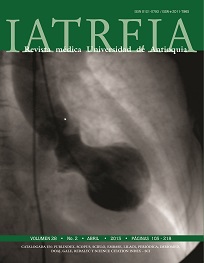Prevalence and clinical impact of sensitization to latex and fruits in dentistry students at the University of Antioquia, and its relationship with allergy to fruits
DOI:
https://doi.org/10.17533/udea.iatreia.v28n2a03Keywords:
allergy, fruits, health care students, hipersensitivity, latexAbstract
Objective: To determine the prevalence and clinical impact of sensitization to latex and to five tropical fruits (banana, avocado, kiwi, pineapple and passion fruit) in dentistry students.
Methods: Analytical cross-sectional study of 128 dentistry students at University of Antioquia in Medellín, Colombia. Information was collected by means of a questionnaire and skin prick tests with latex and fruits were done.
Results: All students reported having had contact with latex. Nine of them informed at least one episode of adverse reaction to contact with latex without proof of sensitization to it. Five reported at least one reaction with one of the fruits, but skin prick tests were negative. Four of the 14 students who reported gastrointestinal symptoms were sensitized to latex or to one of the tested fruits. Overall, latex sensitization rate was 3.1%.
Conclusion: This percentage of sensitization to latex is lower than that in other studies; this may be due to the expression of immune mechanisms other than IgE mediation. We failed to demonstrate a higher sensitization rate to latex as students advanced in their career. The association between gastrointestinal symptoms and sensitization to both fruit and latex is to be emphasized.
Downloads
References
(1.) Taylor JS, Erkek E. Latex allergy: Diagnosis and management. Dermatol Ther. 2004;17(4):289–301.
(2.) Bousquet J, Flahault A, Vandenplas O, Ameille J, Duron JJ, Pecquet C, et al. Natural rubber latex allergy among health care workers: A systematic review of the evidence. J Allergy Clin Immunol. 2006;118(2):447–54.
(3.) Tarlo SM, Sussman GL, Holness DL. Latex sensitivity in dental students and staff: A cross-sectional study. J Allergy Clin Immunol. 1997;99(3):396–401.
(4.) Saary MJ, Kanani A, Alghadeer H, Holness DL, Tarlo SM. Changes in rates of natural rubber latex sensitivity among dental school students and staff members after changes in latex gloves. J Allergy Clin Immunol. 2002;109(1):131–5.
(5.) Heese A, Peters KP, Stahl J, Koch HU, Hornstein OP. Incidence and increase in type I allergies to rubber gloves in dental medicine students. Hautarzt. 1995;46(1):15–21.
(6.) Vangveeravong M, Sirikul J, Daengsuwan T. Latex allergy in dental students: a cross-sectional study. J Med Assoc Thai. 2011;94 Suppl 3:S1–8.
(7.) Gawchik SM. Latex allergy. Mt Sinai J Med. 2011;78(5):759–72.
(8.) Cabañes N, Igea JM, de la Hoz B, Agustín P, Blanco C, Domínguez J, et al. Latex allergy: Position Paper. J Investig Allergol Clin Immunol. 2012;22(5):313–30; quiz follow 330.
(9.) Blanco C. Latex-fruit syndrome. Curr Allergy Asthma Rep. 2003;3(1):47–53.
(10.) Bousquet J, Heinzerling L, Bachert C, Papadopoulos NG, Bousquet PJ, Burney PG, et al. Practical guide to skin prick tests in allergy to aeroallergens. Allergy Eur J Allergy Clin Immunol. 2012;67(1):18–24.
(11.) Garabrant DH, Schweitzer S. Epidemiology of latex sensitization and allergies in health care workers. J Allergy Clin Immunol. 2002;110(2 suppl):S82–95.
(12.) Jones KP, Rolf S, Stingl C, Edmunds D, Davies BH. Lon-gitudinal study of sensitization to natural rubber latex among dental school students using powder-free glo-ves. Ann Occup Hyg. 2004;48(5):455–7.
(13.) Hernández N, Villalta Y, Conde L. Frecuencia de aler-gia al látex en trabajadores del Hospital Militar Cen-tral de la ciudad de Bogotá en el año 2005. Revmed. 2007;15(1): 54-60.
(14.) LaMontagne AD, Radi S, Elder DS, Abramson MJ, Sim M. Primary prevention of latex related sensitisation and occupational asthma: a systematic review. Oc-cup Environ Med. 2006;63(5):359–64.
(15.) Madan I, Cullinan P, Ahmed SM. Occupational ma-nagement of type I latex allergy. OccupMed (Lond). 2013;63(6):395-404.
Downloads
Published
How to Cite
Issue
Section
License
Copyright (c) 2015 Iatreia

This work is licensed under a Creative Commons Attribution-ShareAlike 4.0 International License.
Papers published in the journal are available for use under the Creative Commons license, specifically Attribution-NonCommercial-ShareAlike 4.0 International.
The papers must be unpublished and sent exclusively to the Journal Iatreia; the author uploading the contribution is required to submit two fully completed formats: article submission and authorship responsibility.














